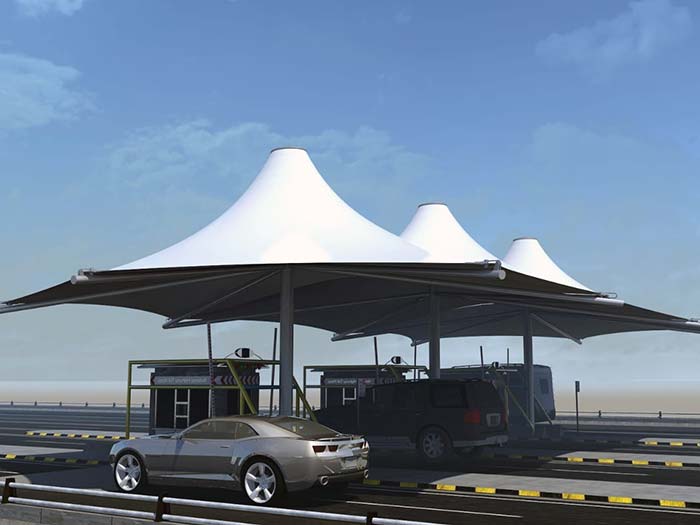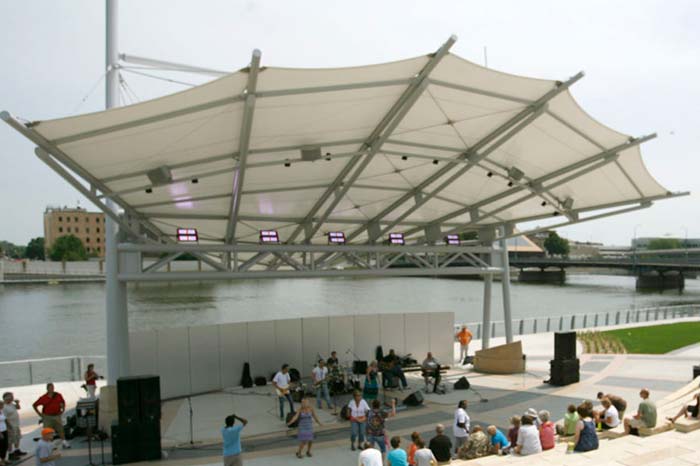Advantages and disadvantages of tensile fabric buildings
Tensile fabric architecture, as an innovative form in the field of modern architecture, has received widespread attention for its unique charm and practicality. This architectural form uses tension to tighten and secure fabric materials to supporting structures, creating a light, flexible and artistic architectural space. However, as everything has its two sides, tensile fabric architecture is no exception. Here’s a closer look at the pros and cons of tensile fabric buildings.
Advantages of Tensile Fabric Buildings
- Light and flexible: One of the best features of tensile fabric building is their light and flexible structure. Due to the fabric material, its weight is much lower than traditional building materials such as concrete and steel. This makes tensile fabric buildings more flexible in design and construction, and can adapt to various terrain and climate conditions to create unique architectural forms.
- Energy saving and environmental protection: Tensile fabric buildings have significant advantages in energy saving and environmental protection. First of all, the fabric material itself has good thermal insulation properties and can effectively reduce energy consumption. Secondly, the construction period of tensioned fabric building is short, which reduces the generation and emission of construction waste. In addition, fabric materials can also be recycled and reused, reducing the environmental pollution caused by construction waste.
- Strong artistry: Tensile fabric building show a strong sense of artistry with their unique shapes and materials. Designers can create a variety of architectural forms and spatial effects through different fabric materials and tensioning methods, adding unique landscapes to the city.
- Low cost: Compared with traditional building materials, the cost of fabric materials is low. In addition, the short construction period of tension fabric buildings reduces labor costs and time costs. This makes tensile fabric buildings have certain advantages in terms of cost and is suitable for various construction projects with limited budgets.

Disadvantages of tensile fabric buildings
- Insufficient durability: Although fabric materials have good thermal insulation properties, their durability is relatively poor. After long-term exposure to sunlight and harsh climate conditions, fabric materials are prone to aging, fading, and damage. This may result in the stability and safety of the building structure being compromised.
- Poor fire resistance: The fire resistance of fabric materials is relatively poor, and it is easy to burn quickly in a fire and produce a large amount of toxic smoke. Therefore, when designing and constructing tensioned fabric buildings, special attention needs to be paid to the installation and maintenance of fire protection measures.
- Poor sound insulation effect: Due to the characteristics of the fabric material itself, the sound insulation effect of tensile structure building is relatively poor. In a noisy environment, the interior of the building is easily disturbed by external noise. Therefore, appropriate sound insulation measures need to be considered when designing and using tension fabric buildings.
- Environmentally sensitive: Tensile fabric buildings are sensitive to environmental factors. In severe weather conditions such as strong winds and heavy rain, building structures may be damaged or destroyed. Therefore, when designing and using tensile structure building, it is necessary to fully consider the impact of environmental factors on the building structure and take corresponding protective measures.

To sum up, as an emerging architectural form, tensile fabric buildings have significant advantages in being light and flexible, energy-saving and environmentally friendly, artistic and low-cost. However, its shortcomings such as insufficient durability, poor fire resistance, poor sound insulation and sensitivity to the environment also require our attention. When designing and using tensile fabric building, we need to fully consider its advantages and disadvantages and take corresponding measures to overcome its shortcomings to give full play to its advantages.